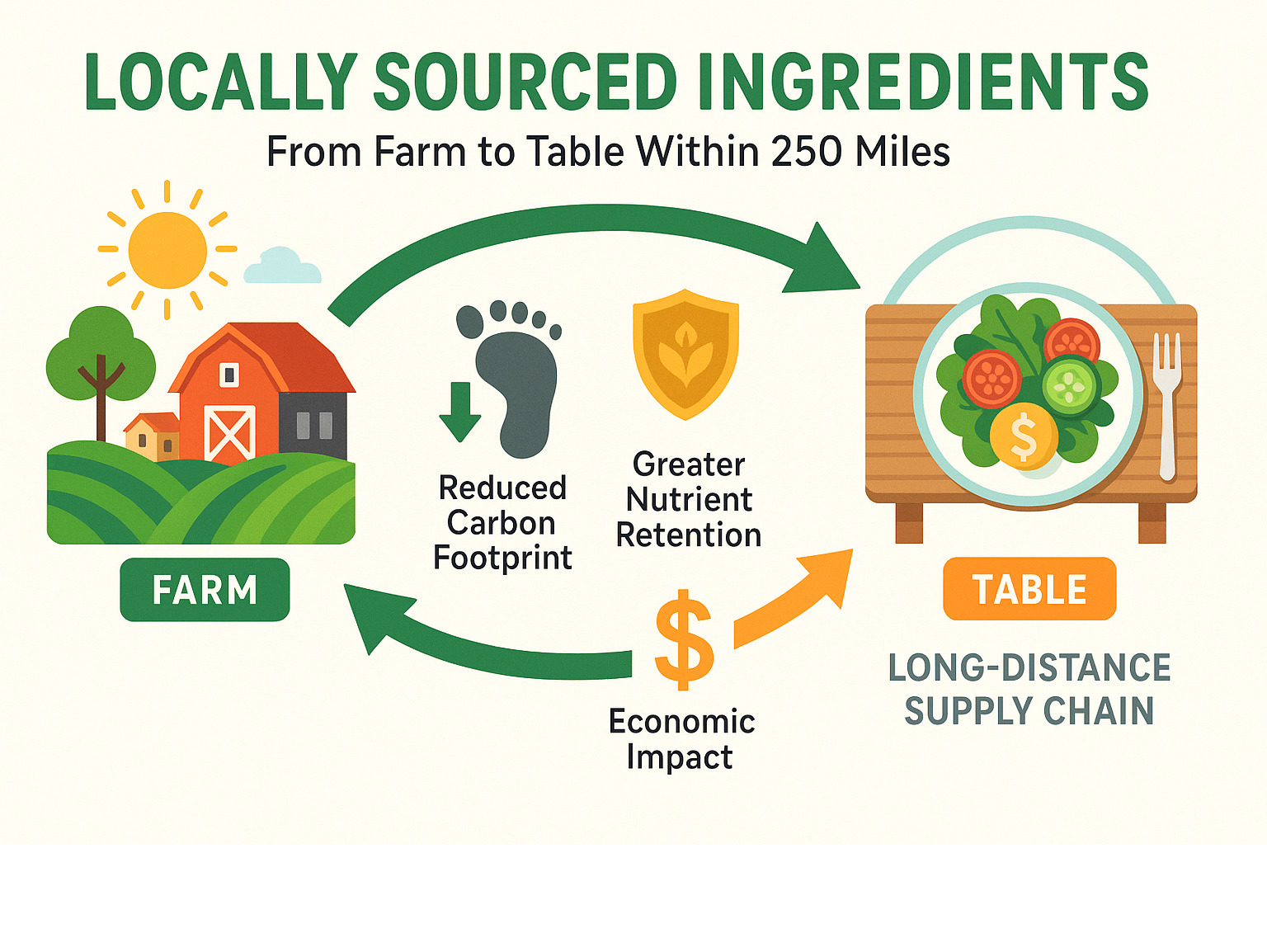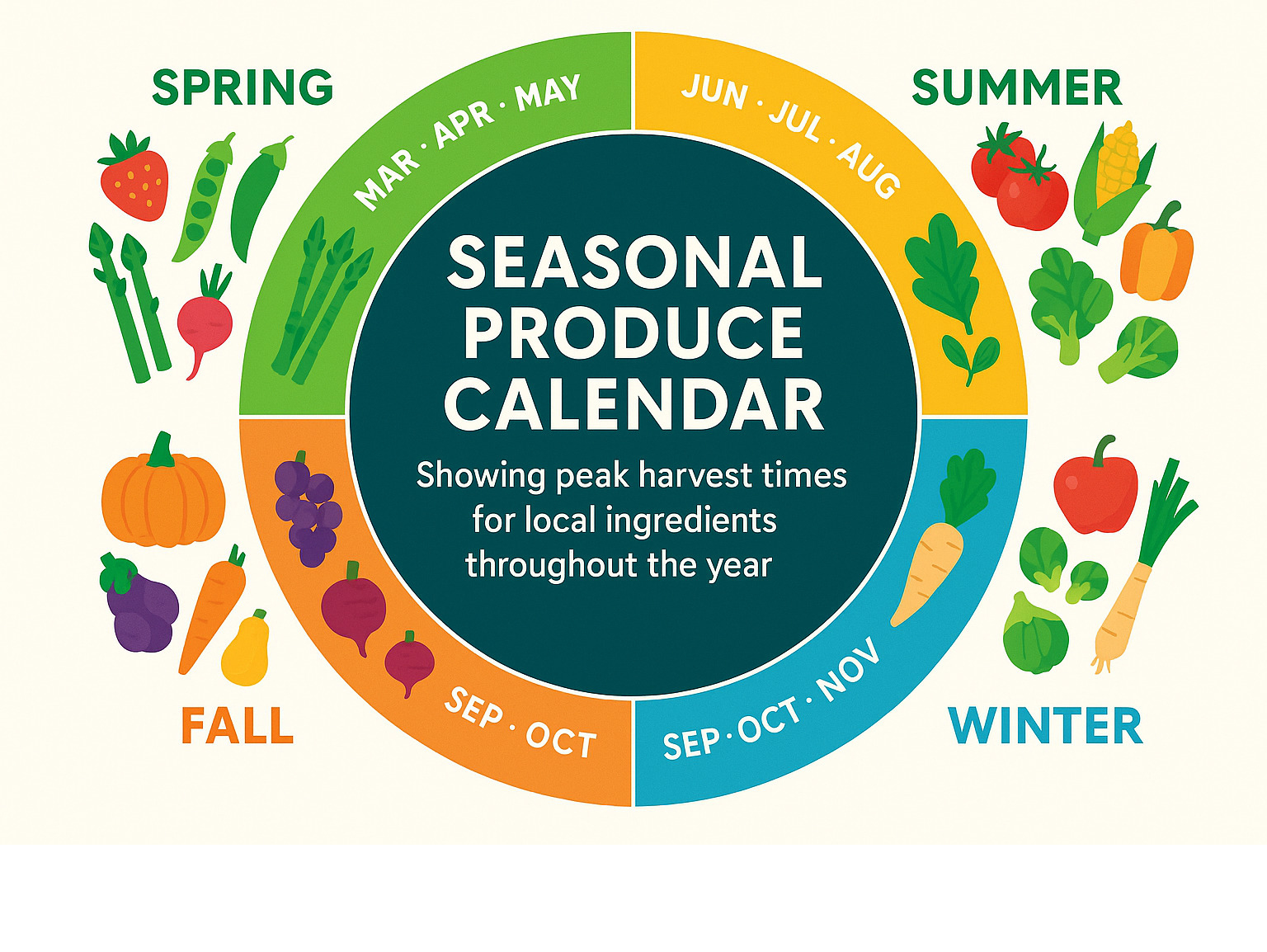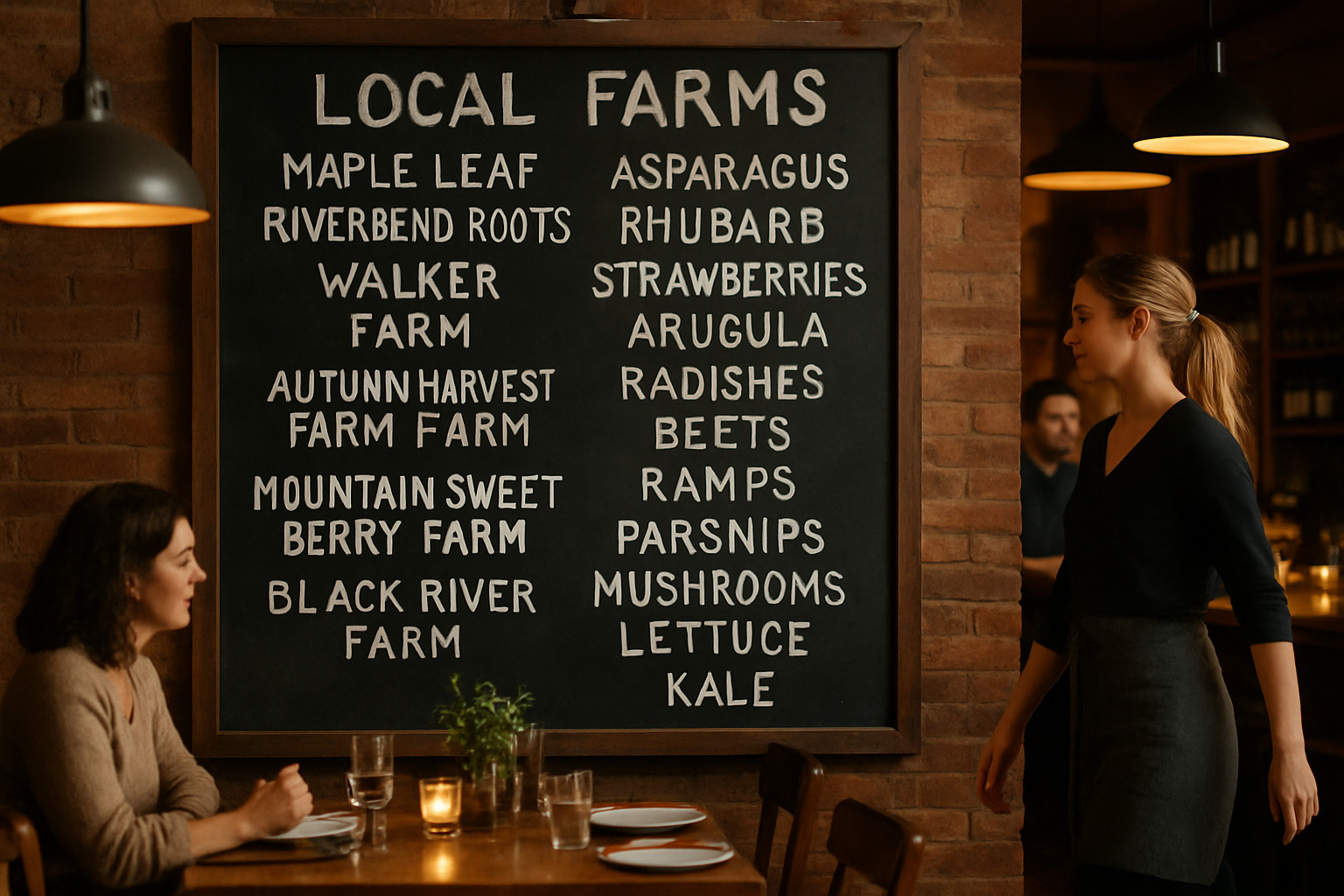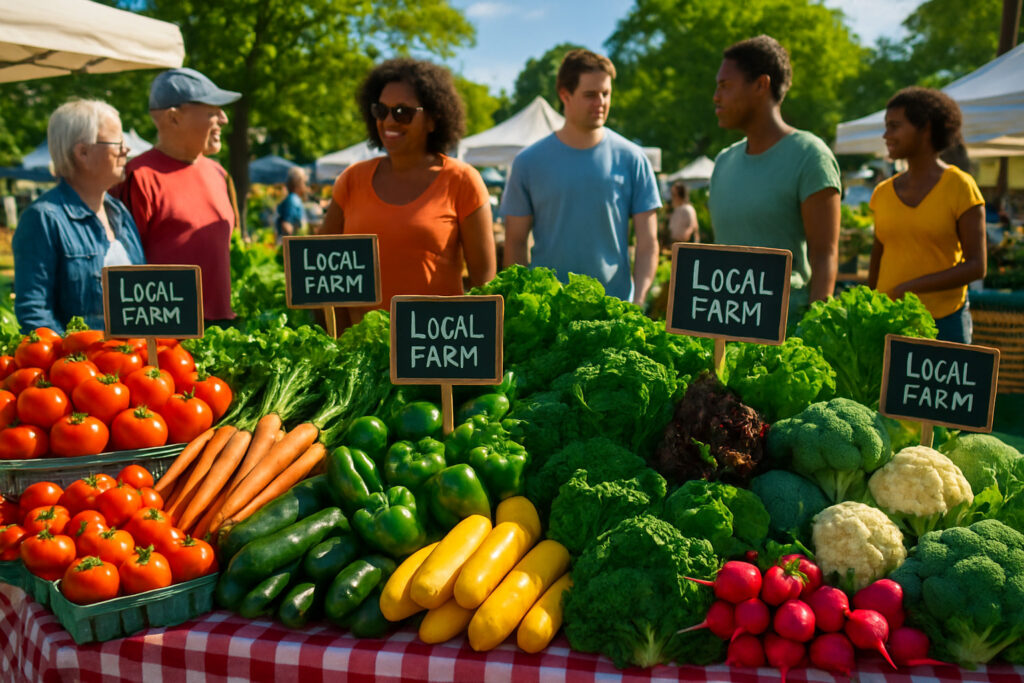Why Locally Sourced Ingredients Are Changing Modern Dining
Locally sourced ingredients are foods grown, produced, or raised within a specific geographic area – typically within 100-250 miles of where they’re consumed. This movement goes far beyond trendy restaurant marketing to deliver measurable benefits for flavor, nutrition, community economics, and environmental sustainability.
Key Benefits of Locally Sourced Ingredients:
- Freshness & Flavor: Harvested at peak ripeness with minimal transport time
- Superior Nutrition: Up to 9x higher nutrient levels than shipped produce
- Economic Impact: Money spent locally stays in the community 7x longer
- Environmental Benefits: Reduced carbon footprint from shorter food miles
- Food Safety: Direct supply chain transparency and traceability
- Community Support: Strengthens local farms and preserves biodiversity
As one hospitality expert noted, “Eating locally grown foods is a habit that more people should make part of their daily lives” – connecting us back to ancestral dietary patterns while supporting modern sustainability goals.
Whether you’re a restaurant owner seeking menu differentiation, an event planner prioritizing sustainability, or a food-loving traveler seeking authentic experiences, understanding locally sourced ingredients opens doors to fresher flavors, stronger communities, and more responsible dining choices.
The shift toward local sourcing isn’t just about shorter distances – it’s about creating transparency in our food system and supporting the farmers and producers who shape our regional food cultures.

Find more about locally sourced ingredients:
What Are Locally Sourced Ingredients?
Locally sourced ingredients are foods that grow, flourish, and find their way to your plate within a surprisingly short distance from home. Think of it as your neighborhood’s edible ecosystem – where farmers, producers, and diners all share the same zip code area, creating a tight-knit food community that benefits everyone involved.
The magic happens within what food experts call the 100 to 250-mile radius. This isn’t just an arbitrary number – it’s the sweet spot where food can travel from farm to fork while still maintaining its peak freshness, nutritional punch, and authentic flavors. Some passionate advocates even accept the “km zero” concept, sourcing ingredients from practically next door.
What makes locally sourced ingredients truly special is something the French call terroir – the idea that every piece of land has its own personality. The soil composition, rainfall patterns, and even the morning fog all work together to create ingredients with unique characteristics. A tomato grown in your region’s specific climate and soil will taste completely different from the same variety grown thousands of miles away, even if they’re genetically identical.
This approach champions direct trade relationships between the people who grow your food and the people who serve it. Instead of ingredients bouncing through multiple warehouses and distributors, they often travel straight from the farmer’s hands to your local restaurant or market. This supply-chain transparency means you can actually know the story behind your meal – sometimes even the name of the farmer who grew your carrots.
Scientific research on nutrient retention reveals something remarkable: locally grown produce can pack up to nine times more nutrients than the same vegetables shipped from distant locations. The reason is simple but powerful – the moment produce is harvested, it starts losing its nutritional value. The shorter the journey from soil to plate, the more vitamins and minerals remain intact.
How Far Is “Local”?
The beauty of “local” lies in its flexibility, but most food professionals agree on some practical guidelines that make sense for different situations.
The 100-mile radius represents the gold standard for restaurants and chefs who want to showcase hyper-local ingredients. This tight circle ensures maximum freshness and allows for direct relationships with nearby farms. Many acclaimed restaurants proudly list farms within this range on their menus.
The 250-mile boundary offers more breathing room while still maintaining the core benefits of local sourcing. This distance works particularly well for event planning standards, where you might need larger quantities of ingredients or more variety than ultra-local sources can provide. It’s also practical for regions where geography or climate limits nearby agricultural options.
The USDA guidelines intentionally avoid setting strict federal definitions, recognizing that “local” means different things in different places. A 100-mile radius in agricultural Iowa covers vastly different terrain than the same distance in mountainous Colorado or desert Arizona.
Modern innovations are reshaping what “local” can mean. Vertical farming and hydroponics operations are sprouting up in urban areas, bringing fresh produce production right into city centers. These high-tech growing methods can deliver truly local ingredients year-round, even in the heart of downtown areas where traditional farming would be impossible.
The key isn’t getting caught up in exact mileage but understanding the spirit behind local sourcing: shorter distances mean fresher food, stronger community connections, and more sustainable food systems that benefit everyone involved.
Why Go Local? Flavor, Nutrition & Safety Advantages
When you choose locally sourced ingredients, you’re not just supporting your community – you’re making a decision that transforms your dining experience in remarkable ways. The difference between local and distant ingredients isn’t subtle; it’s dramatic and measurable.
The Flavor Revolution Starts at Harvest
Picture this: a tomato picked green to survive weeks of shipping versus one that ripened under the sun at a nearby farm. There’s simply no comparison. Locally sourced ingredients taste better because farmers can harvest them at peak ripeness without worrying about extended transit time.
When food doesn’t need to survive weeks of shipping and storage, everything changes. Fruits develop their full spectrum of natural sugars. Vegetables reach complete maturity on the plant, maximizing flavor compounds that only develop through proper ripening. This is something that’s impossible when food must travel thousands of miles.
The freshness advantage extends beyond produce too. Local dairy products have a richness and depth that comes from minimal processing and the absence of preservatives needed for long-distance distribution. Locally raised meat often delivers superior flavor profiles because animals experience less stress and the quality is preserved through shorter processing chains.
Nutrition That Makes a Real Difference
Here’s where the science gets exciting. Scientific research on nutrient retention shows that locally grown produce can contain up to nine times higher nutrient levels than shipped alternatives. Nine times! That’s not a small difference – it’s a game changer.
This dramatic nutritional advantage happens for several reasons. Local produce can be picked at peak nutritional maturity, when vitamin and antioxidant levels are highest. The minimal time between harvest and consumption preserves these vital compounds, while shorter supply chains require fewer preservatives and treatments that can degrade nutritional value.
The WHO report on fresh produce & chronic disease emphasizes how insufficient fresh fruit and vegetable intake contributes to most heart disease and stroke deaths. When locally grown produce delivers significantly higher nutrient density, every bite becomes more valuable for your health.
Safety Through Transparency
Perhaps the most reassuring benefit of locally sourced ingredients is the unprecedented transparency they provide. When you know exactly where your food comes from – and can even visit the farm – you gain direct insight into production methods, safety practices, and quality standards.
This transparency creates natural safety advantages. You can personally verify farming practices and conditions. Shorter supply chains mean fewer intermediaries and fewer opportunities for contamination. If issues arise, they can be identified and addressed rapidly.
Regional farmers often demonstrate more care about quality than large corporations because their reputation directly impacts their local customer base. This personal accountability creates natural incentives for superior safety practices and quality control. When your customers are also your neighbors, quality becomes personal.
Learn more about these compelling benefits in our comprehensive guide: Why Locally Sourced Ingredients Make a Difference
Economy & Ecology: Community, Environment, Biodiversity
Locally sourced ingredients create a beautiful ripple effect that transforms communities and ecosystems in ways that might surprise you. When you choose that tomato from the farmer down the road instead of one shipped from across the country, you’re casting a vote for a more connected, sustainable food system.
Keeping Money in Your Neighborhood
Here’s something fascinating: when you buy locally sourced ingredients, your money doesn’t just disappear into some corporate headquarters thousands of miles away. Instead, it stays in your community up to seven times longer, bouncing from business to business like a friendly neighborhood game of catch.
Think about it this way – when you buy from Maria’s farm stand, Maria uses that money to buy equipment from the local hardware store, hire neighborhood workers, and maybe grab lunch at the café down the street. The hardware store owner then spends money at other local businesses, and the cycle continues. It’s like planting seeds that grow into a stronger local economy.
This community investment creates jobs beyond just farming. Processing facilities, farmers’ markets, delivery services, and even agritourism ventures all spring up around thriving local food systems. Supporting minority-owned farms through local sourcing helps direct restaurant and event spending back into BIPOC communities, creating economic opportunities where they’re needed most.
Lighter Footprints, Healthier Planet
The environmental story of locally sourced ingredients is refreshingly simple: shorter distances mean less environmental impact. When your dinner doesn’t need to travel across continents, it doesn’t need all the fuel, refrigeration, and packaging that long-distance shipping requires.
Those “food miles” add up quickly. Industrial food systems burn fossil fuels for trucking, shipping, and air freight. They need constant refrigeration during weeks of transit. They require layers of packaging to protect food during its journey. Local food systems eliminate most of these environmental costs by keeping the farm-to-table distance short and sweet.
Preserving Tomorrow’s Food Heritage
Local farms are like living libraries, preserving food varieties that industrial agriculture has forgotten. While big operations focus on crops that ship well and look uniform, local farmers can grow heirloom tomatoes with incredible flavors, heritage grains with complex tastes, and traditional varieties that connect us to our food history.
This biodiversity isn’t just about nostalgia – it’s about survival. When farms grow diverse crops, they support healthier ecosystems. Pollinators thrive. Soil stays healthy through crop rotation. Beneficial insects and wildlife find homes among varied plantings.
Local farms often accept organic practices naturally because they’re accountable to their neighbors. When your customers can visit your farm and see how you grow their food, you have every incentive to use sustainable methods that protect both the land and the community.
Explore more about this movement: Local is the New Global: The Hyperlocal Food Movement
How to Source & Serve Locally Sourced Ingredients
Building a successful local sourcing program feels overwhelming at first, but it becomes second nature once you understand the key channels and develop solid relationships with suppliers. Whether you’re cooking for your family or running a restaurant, the same basic principles apply – you just need to scale your approach.
Finding Your Local Food Network
The best place to start your local sourcing journey is at farmers’ markets, where you can meet growers face-to-face and taste their products before committing. These markets give you direct access to the people growing your food, and most vendors are happy to share their growing practices and seasonal availability.
Community Supported Agriculture (CSA) programs offer another excellent entry point into local sourcing. With CSA, you essentially buy a share of a farm’s harvest upfront, then receive weekly or bi-weekly boxes of whatever’s in season. The Local Harvest’s website makes it easy to find CSA programs in your area, including options for vegetables, fruits, dairy, eggs, and meat shares.
For larger volume needs or specific requirements, direct farm relationships provide the most control and often the best pricing. Many farms welcome partnerships with restaurants and institutions, and they can often accommodate special requests like specific varieties or harvest timing.
Modern growing methods like vertical farming and hydroponics are expanding what “local” means, especially in urban areas. These controlled-environment systems can produce fresh leafy greens and herbs year-round within city limits, offering incredibly short food miles and consistent quality regardless of weather.
When evaluating potential suppliers, focus on reliability and transparency above all else. You want partners who can consistently deliver quality products and are open about their growing practices. The best suppliers will invite you to visit their operations and answer questions honestly about what they can and cannot provide.
Seasonal Menu Planning
Working with locally sourced ingredients requires a different approach to menu planning – one that accepts flexibility and seasonal rhythms. Instead of designing a menu and then sourcing ingredients, you’ll learn to plan around what’s available when it’s at its peak.
Successful seasonal menu rotation means designing your offerings around peak harvest times for maximum flavor and availability. This approach naturally leads to more affordable ingredients since you’re buying when supply is highest. It also creates excitement for diners who anticipate seasonal specialties.
The key is developing flexible recipes that can accommodate ingredient substitutions based on availability. Create vegetable-forward dishes that work with whatever seasonal produce is abundant. Master preservation techniques like canning, freezing, and fermenting to extend the life of peak-season ingredients.

Check out our comprehensive guide: Farm-to-Table Dining Experiences
Locally Sourced Ingredients in Your Home Kitchen
Home cooks often find local sourcing more manageable than they expect, especially once they develop systems for handling seasonal abundance and preserving peak-season flavors.
CSA boxes provide an excellent introduction to eating seasonally, but they require some strategy to use effectively. The key is meal planning around your deliveries rather than planning meals and then shopping. When you know you’re getting a box of vegetables every Tuesday, you can plan your week’s cooking around what typically arrives.
Successful CSA members develop strong preservation skills to handle weeks when abundance overflows their immediate needs. Learn basic techniques like blanching and freezing vegetables, quick-pickling excess produce, and dehydrating herbs. These skills transform potential waste into pantry staples that extend local eating through winter months.
Seasonal pantry building means stocking up on locally produced staples during peak seasons. Buy grains and flours from local mills during harvest season, purchase honey directly from beekeepers, and stock your freezer with local berries and prepared foods when they’re abundant and affordable.
Locally Sourced Ingredients for Restaurants & Events
Professional operations require more sophisticated approaches to local sourcing, but the rewards include menu differentiation, customer loyalty, and often surprising cost savings during peak seasons.
Menu engineering for local sourcing starts with building flexibility into your core offerings. Maintain consistent menu items using ingredients available year-round, but feature rotating specials that highlight peak-season ingredients. Use menu language that allows for ingredient substitutions – “seasonal vegetables” instead of listing specific items that might not be available.
Supplier relationship management becomes crucial at professional scales. Establish clear agreements regarding quality standards, delivery schedules, and pricing structures. Maintain regular communication about upcoming harvests and availability. Many successful restaurants offer favorable payment terms to support small farmers who often struggle with cash flow.
The most successful restaurants showcase their local sourcing through transparency and storytelling. Display chalkboard farm lists showing current suppliers, train staff to share stories about local farms with guests, and use social media to feature seasonal ingredients and the farmers who grow them.

For more professional insights: Sustainable Menu Options and Sustainable Dining Practices
Frequently Asked Questions about Locally Sourced Ingredients
When it comes to locally sourced ingredients, we hear the same questions repeatedly from home cooks, restaurant owners, and event planners. Let’s explore the answers that matter most for your local sourcing journey.
What qualifies as “local” food?
The definition of “local” isn’t as straightforward as you might expect – and that’s actually a good thing. Most food professionals work within a 100 to 250-mile radius from where ingredients are consumed, but the exact distance depends on your specific needs and circumstances.
Restaurants emphasizing hyper-local sourcing often stick to the 100-mile rule, creating tight connections with nearby farms and producers. This stricter approach maximizes freshness and minimizes transportation impact, though it can limit ingredient variety.
Event planners and institutional buyers typically use the 250-mile standard, which provides more flexibility while still supporting regional food systems. This broader definition accommodates the larger volumes and consistent supply needed for bigger operations.
The heart of local sourcing goes beyond simple mileage. True locally sourced ingredients share several key characteristics: minimal transportation time, direct relationships between producers and consumers, seasonal availability that reflects natural growing cycles, and complete transparency about production methods.
There’s no federal definition of “local” food, which gives you flexibility to define what works best for your situation. The goal is creating shorter supply chains that support your regional food community while delivering superior quality and freshness.
Is locally sourced more expensive?
Here’s the honest answer: locally sourced ingredients often cost more upfront than mass-produced alternatives, but the real value story is more complex than simple price tags suggest.
Local ingredients typically carry higher costs because small farms operate differently than industrial operations. They use more labor-intensive methods, often employ organic or sustainable practices, and produce smaller batches with greater attention to quality. Without the economies of scale that drive down industrial food prices, local producers need to charge more to sustain their operations.
But price alone doesn’t tell the whole story. Locally sourced ingredients deliver superior flavor, nutrition, and freshness that can actually reduce your overall food costs. Better quality ingredients mean less waste from spoilage, longer shelf life, and more satisfied customers who appreciate the difference.
The community investment aspect adds another layer of value. When you buy locally, that money stays in your regional economy up to seven times longer than purchases from distant suppliers. You’re not just buying ingredients – you’re supporting local jobs and strengthening your food community.
Smart cost management makes local sourcing more affordable. Buy ingredients during peak season when they’re most abundant and affordable. Establish regular relationships with suppliers for better pricing on consistent orders. Learn preservation techniques to extend peak-season ingredients throughout the year.
How do I find reliable local suppliers?
Finding trustworthy local suppliers requires some detective work, but the payoff in quality and relationships makes the effort worthwhile. Start with the most direct approach: visit your local farmers’ markets to meet producers face-to-face.
Farmers’ markets offer the perfect opportunity to assess quality directly and build personal relationships with growers. You can taste their products, ask about growing methods, and get a feel for their reliability and professionalism. Many lasting supplier relationships begin with casual farmers’ market conversations.
Online resources can expand your search significantly. Local Harvest’s website provides comprehensive directories of local farms, farmers’ markets, and CSA programs. Your state agriculture department likely maintains similar directories, and regional food hubs often aggregate multiple local producers for easier sourcing.
Don’t overlook the power of professional networking. Restaurant associations, culinary organizations, and food service trade shows connect you with other professionals who can share supplier recommendations. These peer connections often lead to the most reliable supplier relationships.
When evaluating potential suppliers, focus on production capacity, quality consistency, and communication skills. Can they meet your volume requirements reliably? Do their products maintain consistent quality between deliveries? Do they respond promptly to questions and communicate clearly about availability?
Start small with new suppliers to test their reliability before committing to larger orders. Be clear about your requirements and expectations from the beginning. Offer fair payment terms that support small producers – many local farms operate on tight cash flow and appreciate prompt payment.
Building successful supplier relationships takes time, but the investment pays dividends in consistent quality, reliable supply, and often genuine friendships with the people who grow your food. These relationships become the foundation of successful local sourcing programs.
Conclusion
Locally sourced ingredients represent far more than a passing culinary trend – they’re quietly revolutionizing how we think about food, community, and our planet. After diving deep into this movement, it’s clear that choosing local ingredients creates a ripple effect of benefits that extends from your dinner plate to entire regional economies.
The numbers tell a compelling story. When you bite into that perfectly ripe tomato from a nearby farm, you’re experiencing ingredients that can contain up to nine times higher nutrient levels than their well-traveled counterparts. That superior flavor isn’t just in your head – it’s the result of harvesting at peak ripeness without worrying about surviving weeks of shipping.
But the impact goes beyond personal health and taste. Every dollar spent on locally sourced ingredients stays in your community up to seven times longer than money sent to distant corporate headquarters. This economic multiplier effect strengthens local farms, creates jobs, and builds more resilient food systems that can weather global supply chain disruptions.
For restaurants and food service operations, local sourcing offers something invaluable in today’s competitive market: authenticity. That chalkboard listing nearby farms isn’t just clever marketing – it tells a story that resonates with diners who increasingly want to know where their food comes from. It’s menu differentiation with meaning, creating connections between guests, chefs, and the land that feeds them.
For home cooks, embracing local ingredients connects us back to something we’ve lost in our globalized food system – the rhythm of seasons and the unique character of place. Whether you’re unpacking your weekly CSA box or chatting with farmers at the weekend market, you’re participating in food traditions that span generations.
The environmental benefits are equally impressive. By dramatically reducing food miles, locally sourced ingredients cut transportation emissions while supporting farming practices that often prioritize soil health and biodiversity. Those heirloom tomato varieties and heritage breed animals you find at local farms? They’re genetic treasures that industrial agriculture can’t accommodate.
Perhaps most importantly, local sourcing creates transparency in a food system that’s become increasingly opaque. When you can visit the farm where your vegetables grow or know the name of the farmer who raised your beef, you’re making informed choices aligned with your values.
At The Dining Destination, we’ve seen how the most memorable culinary experiences often feature ingredients that truly reflect their place of origin. That distinctive terroir – whether it’s Alberta’s sweet root vegetables or Italy’s sun-soaked tomatoes – simply can’t be replicated elsewhere. It must be experienced in context, connecting travelers and diners to the authentic flavors of place.
The future of dining is becoming increasingly local, seasonal, and connected to community. By choosing locally sourced ingredients, we’re not just investing in better meals – we’re supporting a food system that values farmers, protects the environment, and creates the kind of authentic culinary experiences that make dining truly memorable.
Ready to explore how sustainability is reshaping the entire dining landscape? Find more in our comprehensive guide: Sustainable Dining: More Than a Trend









1 thought on “Fresh Thinking: How Locally Sourced Ingredients Boost Your Menu”
Pingback: The Complete Guide to Clean Simple Eats: What You Need to Know - The Dining Destination
Comments are closed.